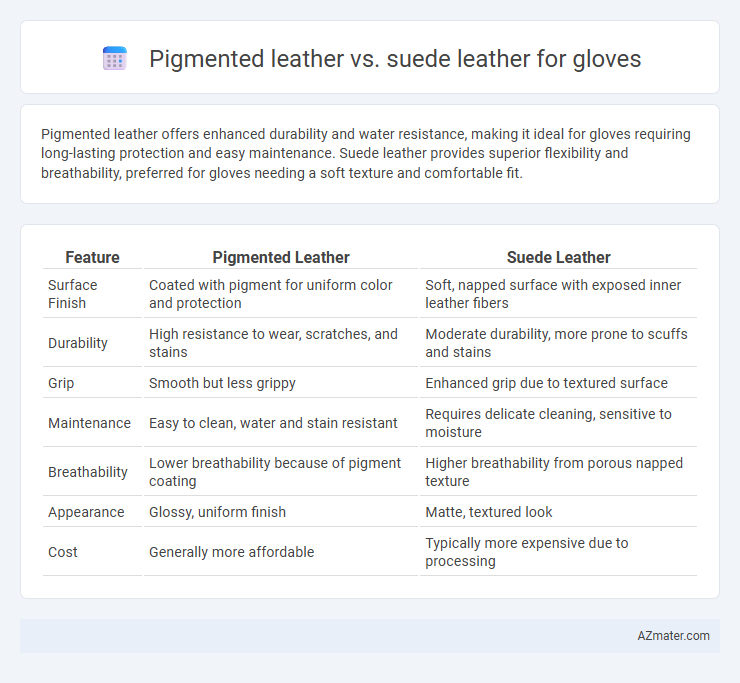Pigmented leather offers enhanced durability and water resistance, making it ideal for gloves requiring long-lasting protection and easy maintenance. Suede leather provides superior flexibility and breathability, preferred for gloves needing a soft texture and comfortable fit.
Table of Comparison
| Feature | Pigmented Leather | Suede Leather |
|---|---|---|
| Surface Finish | Coated with pigment for uniform color and protection | Soft, napped surface with exposed inner leather fibers |
| Durability | High resistance to wear, scratches, and stains | Moderate durability, more prone to scuffs and stains |
| Grip | Smooth but less grippy | Enhanced grip due to textured surface |
| Maintenance | Easy to clean, water and stain resistant | Requires delicate cleaning, sensitive to moisture |
| Breathability | Lower breathability because of pigment coating | Higher breathability from porous napped texture |
| Appearance | Glossy, uniform finish | Matte, textured look |
| Cost | Generally more affordable | Typically more expensive due to processing |
Overview of Pigmented Leather and Suede Leather
Pigmented leather for gloves features a durable surface coating that enhances resistance to stains, water, and abrasion, making it ideal for heavy-duty use and easy maintenance. Suede leather is characterized by its soft, napped texture derived from the underside of the hide, offering superior flexibility and breathability but requiring more care to prevent staining and wear. Both materials serve distinct functional purposes in glove manufacturing, with pigmented leather favoring durability and longevity, while suede emphasizes comfort and tactile sensitivity.
How Pigmented Leather is Made
Pigmented leather for gloves is produced by applying a solid color coating that covers the leather surface, providing a uniform appearance and enhanced durability against stains and wear. This manufacturing process involves embedding pigments into the leather's top layer, followed by a protective clear finish that seals the color and increases resistance to moisture and abrasion. The result is a smooth, sturdy glove material that maintains consistent color and requires minimal maintenance compared to suede leather.
The Suede Leather Manufacturing Process
Suede leather for gloves is crafted by sanding or buffing the inner surface of split leather, creating a soft, textured finish ideal for enhanced grip and flexibility. The manufacturing process involves careful splitting of the hide, precise abrasion to expose the fibrous surface, and treatment with dyes or finishes to improve durability and color retention without compromising the natural nap. This contrasts with pigmented leather, which typically receives a sealed pigment coating on the outer grain surface, emphasizing uniform appearance and water resistance rather than the tactile qualities emphasized in suede production.
Appearance and Texture Comparison
Pigmented leather gloves feature a smooth, uniform surface with a durable, pigmented finish that enhances color vibrancy and provides resistance to stains and wear. Suede leather gloves offer a soft, velvety texture with a matte appearance, showcasing the natural napped finish of the hide that gives a luxurious, tactile feel. The choice between pigmented leather and suede depends on preference for a sleek, polished look versus a plush, textured aesthetic.
Durability: Pigmented vs. Suede Leather Gloves
Pigmented leather gloves feature a protective coating that enhances resistance to abrasion, moisture, and stains, making them significantly more durable in harsh working environments. Suede leather gloves, while offering superior flexibility and breathability, lack the protective pigmented layer, resulting in lower durability and increased susceptibility to wear and tear. For tasks requiring long-lasting gloves, pigmented leather outperforms suede leather in maintaining structural integrity and extending glove lifespan.
Comfort and Flexibility in Glove Use
Pigmented leather offers a durable, water-resistant surface ideal for gloves requiring firm protection, but it may feel stiffer and less breathable, impacting long-term comfort. Suede leather provides superior flexibility and softness, allowing gloves to conform closely to hand movements while enhancing breathability for extended wear. The choice between pigmented and suede leather fundamentally affects glove comfort through trade-offs in flexibility, durability, and moisture control.
Maintenance and Cleaning Requirements
Pigmented leather gloves feature a protective coating that resists stains and moisture, making them easier to clean with mild soap and water and requiring minimal maintenance to maintain their appearance. Suede leather gloves demand more careful upkeep due to their porous surface, which easily absorbs dirt and oils, necessitating specialized suede brushes and erasers for effective stain removal and regular protection with water-repellent sprays. Proper maintenance of pigmented leather extends durability with simple cleaning routines, whereas suede requires consistent, gentle care to preserve texture and prevent damage.
Cost Considerations: Price and Value
Pigmented leather gloves typically offer a more affordable price point due to mass production and easier processing, making them a cost-effective choice for budget-conscious buyers. Suede leather gloves, crafted from the underside of the hide, often command higher prices because of their luxurious texture and more labor-intensive manufacturing process. While pigmented leather balances durability and price, suede gloves deliver superior softness and style, presenting a value proposition driven by preference rather than just cost.
Best Use Cases for Each Leather Type
Pigmented leather gloves offer superior durability and water resistance, making them ideal for heavy-duty tasks such as construction, welding, and outdoor work where protection from abrasion and moisture is critical. Suede leather gloves provide enhanced flexibility and breathability, suited for precision work like gardening, driving, and light assembly where tactile sensitivity and comfort are essential. Choosing pigmented leather excels in harsh environments requiring toughness, while suede leather performs best in applications prioritizing dexterity and softness.
Choosing the Right Leather Glove for Your Needs
Pigmented leather gloves offer superior durability and water resistance, making them ideal for heavy-duty tasks and outdoor work environments. Suede leather gloves provide enhanced flexibility and breathability, which suits precision tasks and indoor use where comfort and dexterity are priorities. Selecting between pigmented and suede leather gloves depends on the balance between protection required and tactile sensitivity needed for specific applications.

Infographic: Pigmented leather vs Suede leather for Glove
 azmater.com
azmater.com